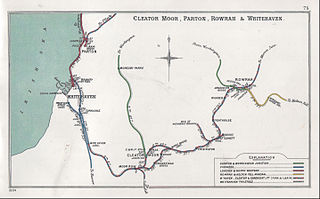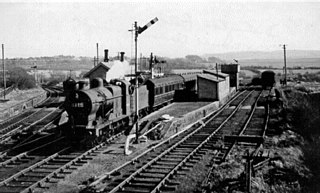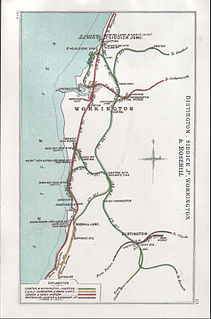
Moor Row railway station was built by the Whitehaven, Cleator and Egremont Railway. It served the village of Moor Row, Cumbria, England.
Woodend railway station was planned by the Whitehaven, Cleator and Egremont Railway on its Sellafield to Moor Row branch, but by the time the station opened the company had been bought out by the LNWR and Furness Railway who operated the line jointly until grouping in 1923.

Cleator Moor has had three passenger stations:

Cleator Moor West railway station was opened as "Cleator Moor" by the Cleator and Workington Junction Railway (C&WJR) in 1879. It served the growing industrial town of Cleator Moor, Cumbria, England.

Seaton railway station served the village of Seaton, near Workington in Cumberland, England.

Rowrah railway station was built by the Whitehaven, Cleator and Egremont Railway. It served the village of Rowrah, Cumbria, England.
Ullock railway station was built by the Whitehaven, Cleator and Egremont Railway. It served the village of Ullock, Cumbria, England.

Winder railway station was built by the Whitehaven, Cleator and Egremont Railway. It served the village of Winder, Frizington, Cumbria, England.

Yeathouse railway station was a later addition to the Whitehaven, Cleator and Egremont Railway. It served the communities of Yeathouse and Eskett, near Frizington, Cumbria, England.

Frizington railway station was built by the Whitehaven, Cleator and Egremont Railway. It served the industrial Parkside area of Frizington, Cumbria, England.
Egremont railway station was built by the Whitehaven, Cleator and Egremont Railway as the first southern terminus of what would become the Moor Row to Sellafield branch. In 1878 the company was bought out by the LNWR and Furness Railway who operated the line jointly until grouping in 1923.
St Thomas Cross Platform was a railway station used by workmen's trains on the Moor Row to Sellafield line on what is now the southeastern, Cringlethwaite, edge of Egremont, Cumbria, England.
Beckermet Mines railway station was situated at Pit No.1 of the mine of the same name. It was used by workmen's trains which travelled along a branch which curved eastwards off the Moor Row to Sellafield line, primarily to handle the iron ore lifted at the site.
Keekle Colliers' Platform railway station was opened by the Cleator and Workington Junction Railway (C&WJR) in July 1910, closed the following January, reopened in June 1913 then closed for good on 1 October 1923. The halt was provided to enable residents of the isolated Keekle Terrace, less than 100 yds from the track, to get to and from work at the equally isolated Walkmill Colliery and coke ovens in Cumbria, England. The Platform is not shown by Jowett.

Moresby Parks railway station was opened by the Cleator and Workington Junction Railway (C&WJR) in 1879. It was situated just north of the summit of the company's main line and served the scattered community of Moresby Parks in Cumbria, England.
Millgrove railway station was a private station on the Cleator and Workington Junction Railway (C&WJR) main line from Moor Row to Workington Central. It appears to have served the Burnyeat family who lived at a house named Millgrove in Moresby, Cumbria, England, which was near the company's main line. William Burnyeat (1849-1921) was on the company's Board of Directors from 1900 to 1921.

Distington railway station was opened jointly by the Cleator and Workington Junction Railway (C&WJR) and the LNWR and Furness Joint Railway on 1 October 1879. It was situated on the northern edge of the village of Distington, Cumbria, England, where the C&WJR's north–south main line crossed the Joint Line's east–west Gilgarran Branch.

Harrington railway station, or Church Road halt, was a railway station in Harrington, Cumbria, England. It was opened by the Cleator and Workington Junction Railway (C&WJR) on the company's Harrington Branch which connected with the Lowca Light Railway at Rosehill to provide a through route from Lowca to Workington Central and beyond.

Buckhill Colliery Halt railway station was an unadvertised halt for workers at Buckhill Colliery north east of Camerton, near Cockermouth in Cumberland, England.

Oatlands railway station served the village of Pica and Oatlands Colliery in the former English county of Cumberland, now part of Cumbria.







